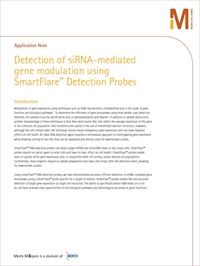Members Login

Channels
Special Offers & Promotions
Novel RNA detection reagent enables gene expression analysis in living cells
In this new application note, Millipore describes how a Novel RNA detection reagent enables gene expression analysis in living cells.
 This technology allows for carrier- free cellular endocytosis of the reagent, followed by detection and relative quantitative analysis of RNA levels. Because the reagent leaves the cell after the detection event, the same sample can be used for any downstream analysis, meaning you can assess multiple biomarkers or downstream functionalities in the same cells. Additionally, this reagent requires no upfront sample preparation, has no toxic effects on cellular fate and no known nonspecific, off-target effects.
This technology allows for carrier- free cellular endocytosis of the reagent, followed by detection and relative quantitative analysis of RNA levels. Because the reagent leaves the cell after the detection event, the same sample can be used for any downstream analysis, meaning you can assess multiple biomarkers or downstream functionalities in the same cells. Additionally, this reagent requires no upfront sample preparation, has no toxic effects on cellular fate and no known nonspecific, off-target effects.
Detecting gene expression has traditionally been limited to technologies that examine expression in lysed or fixed cell populations. The ability to detect RNAs in individual, live cells can enable an unequivocal assessment of gene expression changes that occur in direct response to specified perturbations. Determining which genes are up- or down-regulated in these perturbed cells provides insight into the relationships between gene expression networks and cell functions.
Compared to currently used methods for interrogating RNA that involve examination of non-native, amplified RNA targets, the probe has the potential to provide results that show greater correlation to in vivo observations. In vivo, most cells reside in heterogeneous tissues, and cell-to-cell variation in gene expression can be subtle yet crucial for tissue function. The technology can be used to quantitate RNAs in individual cells, providing heretofore unobtainable gene expression information that distinguishes one heterogeneous cell population from another with high resolution.
view application note 'Detection of siRNA-mediated gene modulation using SmartFlare™ Detection Probes'
more news from Merck Millipore
Media Partners


